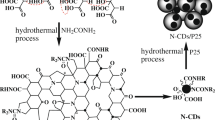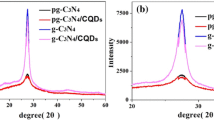Abstract
Design and controllable synthesis of photocatalysts and tailoring their catalytic property such as degradation performance of organic dyes are an interesting subject. We reported the preparation of nitrogen-doped carbon quantum dots/TiO2 composites (N-CDs/TiO2) by hydrothermal process using urea and tetrabutyl titanate (TBT) as precursors. The morphology and chemical structure of N-CDs/TiO2 (N-CDs/TiO2-X, where X is the mass ratio of urea to TBT) were characterized by scanning electron microscopy, transmission electron microscopy, X-ray photoelectron spectroscopy, and electron paramagnetic resonance. We found that the fine N-CDs have the specific properties that it can tune the growth behavior of TiO2 in micrometer size. With the decrease in the ratio of N-CDs to TBT, the morphology of as-fabricated N-CDs/TiO2 changes from hollow spheres, honeycomb to agglomerations bulks, with changing their crystalline phase accordingly. The degradation testing of rhodamine B (RhB) under visible-light irradiation (λ ≥ 400 nm) shows that the photocatalytic performance of N-CDs/TiO2-X substantially improved relative to pure TiO2, while calcinations process substantially decreased the catalytic activity. The optimal photocatalytic performance of N-CDs/TiO2-1 totally removed the RhB in 120 min, which is 11.42 times over that of TiO2. Radical trapping experiment and EPR spin-trapping study show that the ·O2− radical and h+ were the main active species that account for the photodegradation performance.














Similar content being viewed by others
References
Khalid NR, Majid A, Tahir MB, Niaz NA, Khalid S (2013) Carbonaceous-TiO2 nanomaterials for photocatalytic degradation of pollutants: a review. Ceram Int 43:14552–14571. https://doi.org/10.1016/j.ceramint.2017.08.143
Tahir MB, Nabi G, Khalid NR, Rafique M (2018) Role of europium on WO3 performance under visible-light for photocatalytic activity. Ceram Int 44:5705–5709. https://doi.org/10.1016/j.ceramint.2017.12.223
Hendrix Y, Lazaro A, Yu QL, Brouwers HJH (2019) Influence of synthesis conditions on the properties of photocatalytic titania–silica composites. J Photochem Photobiol A Chem 371:25–32. https://doi.org/10.1016/j.jphotochem.2018.10.040
Khalid NR, Iaqat M, Tahir MB, Nabi G, Iqbal T, Niaz NA (2018) The role of graphene and europium on TiO2 performance for photocatalytic hydrogen evolution. Ceram Int 44:546–549. https://doi.org/10.1016/j.ceramint.2017.09.209
Khalid NR, Ahmed E, Niaz NA, Nabi G et al (2017) Highly visible light responsive metal loaded N/TiO2 nanoparticles for photocatalytic conversion of CO2 into methane. Ceram Int 43:6771–6777. https://doi.org/10.1016/j.ceramint.2017.02.093
Tahir MB, Sagir M (2019) Carbon nanodots and rare metals (RM = La, Gd, Er) doped tungsten oxide nanostructures for photocatalytic dyes degradation and hydrogen production. Sep Purif Technol 209:94–102. https://doi.org/10.1016/j.seppur.2018.07.029
Tahir MB, Nabi G, Khalid NR (2018) Enhanced photocatalytic performance of visible-light active graphene–WO3 nanostructures for hydrogen production. Mater Sci Semicond Process 84:36–41. https://doi.org/10.1016/j.mssp.2018.05.006
Negin F, Rokhsareh A, Meghdad P, Tien-Chien J, Yadolah F, Anvar A (2019) Chitosan modified N, S-doped TiO2 and N, S-doped ZnO for visible light photocatalytic degradation of tetracycline. Int J Biol Macromol 132:360–373. https://doi.org/10.1016/j.ijbiomac.2019.03.217
Noushin R, Akbar E, Simin N, Ehsan P, Anvar A (2017) Optimizing parameters on nanophotocatalytic degradation of ibuprofen using UVC/ZnO processes by response surface methodology. Pol J Environ Stud 26:785–794. https://doi.org/10.15244/pjoes/64931
Simin N, Mohammad OB, Ali E, Roshanak RK, Babak K, Mika S, Anvar A (2018) Photocatalytic degradation of malathion using Zn2+-doped TiO2 nanoparticles: statistical analysis and optimization of operating parameters. Appl Phys A 124:175. https://doi.org/10.1007/s00339-018-1599-0
Meghdad P, Anvar A, Mika S, Negin F (2018) Application of carbon quantum dots to increase the activity of conventional photocatalysts: a systematic review. J Mol Liq 271:857–871. https://doi.org/10.1016/j.molliq.2018.09.064
Hamideh B, Akbar E, Ramin N, Anoushiravan M-B, Anvar A, Mika S (2018) Degradation of trichloroethylene by sonophotolytic-activated persulfate processes: optimization using response surface methodology. J Clean Prod 198:1210–1218. https://doi.org/10.1016/j.jclepro.2018.07.100
Tahir MB, Nabi G, Iqbal T, Sagir M, Rafique M (2018) Role of MoSe2 on nanostructures WO3–CNT performance for photocatalytic hydrogen evolution. Ceram Int 44:6686–6690. https://doi.org/10.1016/j.ceramint.2018.01.081
Ao Y, Xu J, Fu D, Yuan C (2009) A simple method to prepare N-doped titania hollow spheres with high photocatalytic activity under visible light. J Hazard Mater 167:413–417. https://doi.org/10.1016/j.jhazmat.2008.12.139
Zhao W, Feng L, Yang R, Zheng J, Li X (2011) Synthesis, characterization, and photocatalytic properties of Ag modified hollow SiO2/TiO2 hybrid microspheres. Appl Catal B Environ 103:181–189. https://doi.org/10.1016/j.apcatb.2011.01.025
Teng F, Hu K, Ouyang W, Fang X (2018) Photoelectric detectors based on inorganic p-type semiconductor materials. Adv Mater. https://doi.org/10.1002/adma.201706262
Diebold U, Ruzycki N, Herman GS, Selloni A (2003) One step towards bridging the materials gap: surface studies of TiO2 anatase. Catal Today 85:93–100. https://doi.org/10.1016/s0920-5861(03)00378-x
Amano F, Yasumoto T, Prieto-Mahaney O-O, Uchida S, Shibayama T, Ohtani B (2009) Photocatalytic activity of octahedral single-crystalline mesoparticles of anatase titanium(IV) oxide. Chem Commun 2019:2311–2313. https://doi.org/10.1039/b822634b
Deng X, Wei Z, Cui C, Liu Q, Wang C, Ma J (2018) Oxygen-deficient anatase TiO2@C nanospindles with pseudocapacitive contribution for enhancing lithium storage. J Mater Chem A 6:4013–4022. https://doi.org/10.1039/c7ta11301c
Bae JY, Jang SG (2019) Preparation and characterization of CuO–TiO2 composite hollow nanospheres with enhanced photocatalytic activity under visible light irradiation. J Nanosci Nanotechnol 19:6363–6368. https://doi.org/10.1166/jnn.2019.17050
Subalakshmi K, Senthilselvan J (2018) Effect of fluorine-doped TiO2 photoanode on electron transport, recombination dynamics and improved DSSC efficiency. Sol Energy 171:914–928. https://doi.org/10.1016/j.solener.2018.06.077
Rai P (2019) Plasmonic noble metal@metal oxide core-shell nanoparticles for dye-sensitized solar cell applications. Sustain Energy Fuels 3:63–91. https://doi.org/10.1039/c8se00336j
Kondo Y, Yoshikawa H, Awaga K et al (2008) Preparation, photocatalytic activities, and dye-sensitized solar-cell performance of submicron-scale TiO2 hollow spheres. Langmuir 24:547–550. https://doi.org/10.1021/la702157r
Zhang G, Wu HB, Song T, Paik U, Lou XW (2014) TiO2 hollow spheres composed of highly crystalline nanocrystals exhibit superior lithium storage properties. Angew Chem Int Ed 53:12590–12593. https://doi.org/10.1002/anie.201406476
Shang S, Jiao X, Chen D (2012) Template-free fabrication of TiO2 hollow spheres and their photocatalytic properties. ACS Appl Mater Interfaces 4:860–865. https://doi.org/10.1021/am201535u
Kisung L, Hyewon Y, Changui A, Junyong P, Seokwoo J (2019) Strategies to improve the photocatalytic activity of TiO2:3D nanostructuring and heterostructuring with graphitic carbon nanomaterials. Nanoscale 11:7025–7040. https://doi.org/10.1039/C0NR01260E
Liu S-Q, Dai G-P, Liang Y, Liu H-J, Liang G-J (2013) Fabrication and visible-light photocatalytic activity of in situ carbon and nitrogen co-doped TiO2 hollow sphere. Acta Phys Chim Sin 29:585–589. https://doi.org/10.3866/pku.whxb201212253
Liu L, Li P, Adisak B et al (2014) Gold photosensitized SrTiO3 for visible-light water oxidation induced by Au interband transitions. J Mater Chem A 2:9875–9882. https://doi.org/10.1039/c4ta01988a
Acknowledgements
This work was supported by grants from National Natural Science Foundation of China (Nos. 21873084 and 21473161), Zhejiang Provincial Natural Science Foundation of China (LZ17B030001), Alexander von Humboldt Foundation (No. 1141172), and Zhejiang SCI-TECH University for 521 distinguished scholar’s scheme.
Author information
Authors and Affiliations
Corresponding author
Ethics declarations
Conflict of interest
There are no conflicts to declare.
Additional information
Publisher's Note
Springer Nature remains neutral with regard to jurisdictional claims in published maps and institutional affiliations.
Rights and permissions
About this article
Cite this article
Ouyang, H., Huang, H., Wang, H. et al. The morphology evolution of nitrogen-doped carbon quantum dots/hollow TiO2 composites and their applications in photocatalysis. J Mater Sci 55, 976–989 (2020). https://doi.org/10.1007/s10853-019-03991-x
Received:
Accepted:
Published:
Issue Date:
DOI: https://doi.org/10.1007/s10853-019-03991-x




